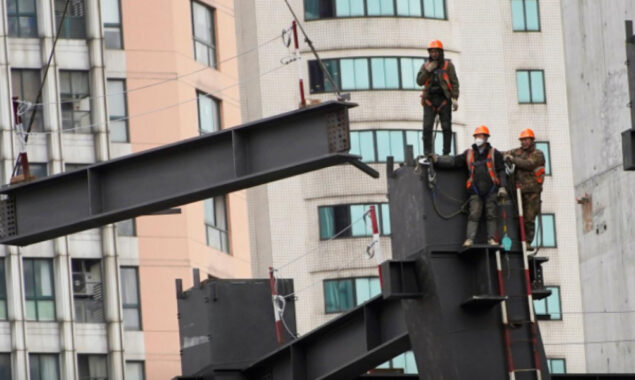Synopsis
BEIJING: Although first-quarter growth may have picked up due to a strong start early in the year, China is projected to record a dramatic decline in economic activity in March as COVID-19 outbreaks and lockdowns hurt consumers and enterprises.

BEIJING: Although first-quarter growth may have picked up due to a strong start early in the year, China is projected to record a dramatic decline in economic activity in March as COVID-19 outbreaks and lockdowns hurt consumers and enterprises.
According to a Reuters poll, data on Monday will show that GDP rose 4.4 percent in January-March from a year earlier, exceeding the fourth-4.0 quarter’s percent rate due to a surprisingly strong start in the first two months.
On a quarterly basis, however, GDP growth is expected to slow to 0.6 percent in the first quarter from 1.6 percent in October-December, according to the survey, indicating a slowing trend.
Separate data on March activity, particularly retail sales, is expected to indicate an even greater decline, according to analysts, as China’s rigorous measures to limit its largest COVID outbreak since the coronavirus was first found in the city of Wuhan in late 2019 struck the country hard.
Analysts predict that April readings will be worse, owing to ongoing lockdowns in business hub Shanghai and elsewhere. According to some economists, the chances of a recession are increasing.
The government is expected to report Q1 and March numbers on Monday at 0200 GMT, raising investor uncertainty over whether extra stimulus measures will be taken.
For the first time this year, the central bank of China announced late Friday that it will reduce the amount of cash that banks must retain as reserves, releasing around 530 billion yuan ($83.25 billion) in long-term liquidity.
The action was widely anticipated after the State Council, or cabinet, stated on Wednesday that monetary policy measures, including as reserve requirement ratio (RRR) reductions, should be deployed as soon as possible.
Policymakers must guarantee that nothing goes wrong before the ruling Communist Party’s twice-decade conference in the autumn, when President Xi Jinping is almost expected to win a record-breaking third term as leader, according to policy insiders.
However, Beijing’s strong zero-tolerance attitude on COVID-19 is wreaking havoc on the world’s second-largest economy, disrupting global supply chains ranging from automobiles to iPhones.
“In the run-up to the Party Congress, we think the central bank will prioritise growth, especially as the COVID battle drags on and housing markets fail to rebound,” analysts at Barclays said in a note.
Retail sales, a measure of consumption that has been trailing since COVID-19 was first detected, are expected to have decreased by 1.6 percent in March compared to the same month a year ago. According to the poll, that would be the lowest result since June 2020, erasing a 6.7 percent growth in the first two months.
Industrial output likely increased 4.5 percent year over year in March, down from 7.5 percent in the first two months, while fixed-asset investment likely increased 8.5 percent in January-March, down from 12.2 percent in the first two months.
According to a Reuters poll, the growth of China would decline to 5.0 percent in 2022, implying that the government will have a difficult time meeting this year’s objective of roughly 5.5 percent.
If Shanghai’s extended lockdown lasts one month and partial lockdowns in the rest of the country last two months, Barclays estimates that second-quarter GDP growth will fall to 3%, dragging growth in 2022 to 4.2 percent.
Imports of China fell in March, reflecting declining domestic demand and COVID-related logistical snarls, while exports, the final big growth driver, are exhibiting symptoms of tiredness.
This year, the government has announced more economic stimulus, including an increase in municipal bond issuance to fund infrastructure projects and tax cuts for businesses.
However, while factories and businesses struggle and consumers remain hesitant about spending, analysts are unsure if rate cuts will do anything to prevent the economic recession in the near term. Capital outflows could be triggered by more aggressive easing, placing further pressure on Chinese financial markets.
“I don’t think this RRR cut (on Friday) matters that much for the economy at this stage,” said Zhiwei Zhang, chief economist at Pinpoint Asset Management, noting it was less than markets had expected.
“The main challenge the economy faces is the Omicron outbreaks and the lockdown policies that restrict mobility. More liquidity may help on the margin, but it doesn’t address the root of the problem. Manufacturers face the daunting risk of supply chain disruptions.
“Unless we see effective policies to address the mobility problem, the economy will slow. I expect GDP growth in Q2 to turn negative.”
For the latest Business News Follow BOL News on Google News. Read more on Latest Business News on oldsite.bolnews.com
Read More News On
Catch all the Business News, Breaking News Event and Latest News Updates on The BOL News
Download The BOL News App to get the Daily News Update & Follow us on Google News.




